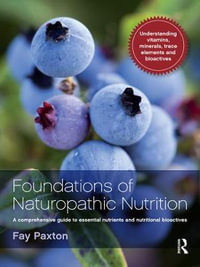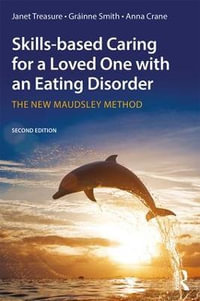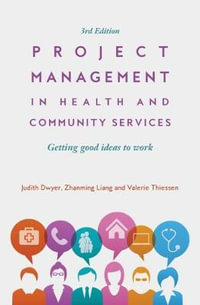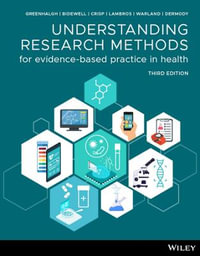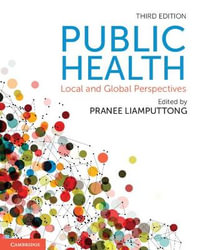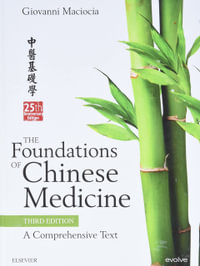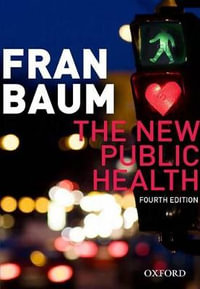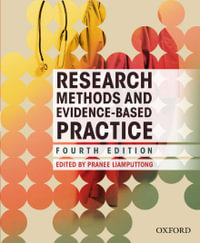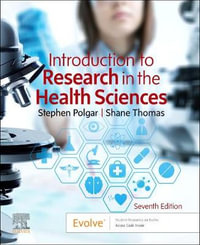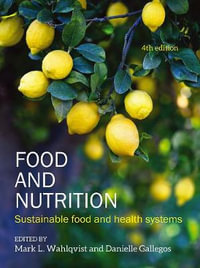
Scientific American Nutrition for a Changing World
2nd Edition - Dietary Guidelines for Americans 2020-2025 & Digital Update
By: Jamie Pope, Steven Nizielski
Paperback | 1 December 2021 | Edition Number 2
At a Glance
688 Pages
2.4 x 23.3 x 27.8
New Edition
Paperback
$431.50
or 4 interest-free payments of $107.88 with
orAims to ship in 10 to 15 business days
Written and illustrated in the style of Scientific American magazine, Nutrition for a Changing World engages students like no other nutrition textbook. Chapters focus on real stories—about real people and real science—bringing context and relevance to the core science. Infographics serve as “science storyboards,” guiding students step by step through essential processes and concepts. Coverage of timely topics—gluten-free diets, the diabetes epidemic, global nutrition—exemplify the book’s contemporary approach to nutrition science.
Nutrition for Changing World is also the only product for the course to offer AnalyzeMyDiet, a diet tracker with personalized, auto-graded diet analysis activities, freeing instructors from hand-grading these projects. New to this Digital Update edition:
The Second Edition Dietary Guidelines for Americans and Digital Update reflects the ever-changing science of nutrition and responds to feedback from the community of introductory nutrition instructors.
In the text, you’ll find:
- The latest Dietary Guidelines for Americans (2020-2025)
- 21 revised Infographics
- The same pagination as the Second Edition, but with the latest statistics and findings in a “write-to-fit” update, so you don’t have to update your syllabus.
Achieve is proven to engage students at all levels both inside and outside of the classroom, elevating individual and classwide performance.
Featured in Achieve:
AnalyzeMyDiet provides both a diet tracker and personalized, auto-graded diet analysis activities, freeing instructors from hand-grading diet analysis projects.
Auto-graded AnalyzeMyDiet activities. Students are asked to do one or two calculations per activity (to help prepare them for exams), all questions--calculations and multiple choice-- contain error specific feedback, students are provided with overall analytics on the activity, and instructors can view Timeline videos when meeting with students 1:1 to see where they might have trouble while completing the activity.
Real-World Nutrition activities have been reimagined so that there is one per chapter and Spotlight. Chapter activities contain advanced question types, like drag-and-drop, sorting, ranking and more, along with feedback and hints. Spotlight activities provide scenario-based exercises so students can apply material they’ve learned.
Error specific feedback and hints in Chapter Reading Quizzes, Real World Nutrition activities, Animations Quizzes.
In Class Activity Guides for every chapter, as well as Student Study Guides that instructors can edit and make available for student use.
Interactive e-book—paginated, fully searchable and downloadable for offline reading. Features such as highlighting, flash cards, bookmarks, and note-taking make the e-book an effective study tool.
Revised LearningCurve adaptive quizzing with more questions per chapter, increased use of images from the text, and the replacement of fill-in-the-blank questions with multiple choice.
About the Authors
Jamie Pope, M.S., R.D., has been with Vanderbilt University since 1986, working in the areas of obesity research, weight management, health promotion, heart disease prevention. Since 2000, she has been Instructor of Nutrition in the School of Nursing. In addition to her current work on Nutrition for a Changing World, Jamie co-authored several best-selling books, including The T-Factor Fat Gram Counter, and is author of The Last Five Pounds: A Liberating Guide to Living Thin. She has authored or contributed to numerous other scientific and popular press publications. Jamie’s popular classes bring together undergraduate students from a wide range of majors to learn about nutrition science and its application to their personal and professional lives. Jamie is a long-time member of the Academy of Nutrition and Dietetics and served as media representative for the Tennessee Dietetic Association, during which time she was named as Outstanding Dietitian of the Year for the Nashville District Dietetic Association. Jamie served for over a decade as nutrition consultant for Smart Balance, Inc.
Steven Nizielski, M.S., Ph.D., earned his Bachelor of Science degree from the University of Minnesota in Wildlife Biology and assisted in research projects involving Siberian tigers and grey wolves before entering graduate school. He earned his masters and doctorate degrees at the University of Minnesota in nutrition with an emphasis in biochemistry. He is currently an associate professor in the Department of Biomedical Sciences at Grand Valley State University in Allendale, Michigan, where he teaches introductory nutrition, clinical nutrition, public health, advanced metabolism, and sports nutrition courses. His current research seeks to identify cellular adaptations in adipose tissue in response to aging and endurance training. Steve is a fellow of The Obesity Society, and a member of the American Society for Nutrition (ASN) and of the American Physiological Society (APS). He is an avid competitive cyclist, and also enjoys cross-country skiing, hiking, and camping.
Industry Reviews
Chapter 1. The Science and Scope of Nutrition
Eating for a Lifetime: A new field in nutrition research is revealing surprising details about how food affects our genes.
Introducing the science of nutrition
Food provides nutrients and energy
What is malnutrition?
Energy Recommendations
Nutrition Science in Action
Credible Sources of Nutrition Information
Health Goals for Americans
Assessing the North American Diet
Chapter 2. Healthy Diets
From Desert to Oasis: Are ""food deserts"" preventing millions of Americans from eating well?
Healthy diets feature variety, balance, adequacy, and moderation
Understanding the nutrient density and energy density of foods
Limit these: solid fats and added sugars
Dietary Guidelines for Americans
Understanding the labeling on food
Menu labeling
Chapter 3. Digestive System and Digestive Disorders
A Gut Feeling: Is gluten really all that bad?
Overview of the Digestive Process
Overview of Mechanical and Chemical Digestion
The Path of Digestion from the Mouth to the Large Intestine
The Role of Bacteria in the Gastrointestinal Tract
Digestive Disorders
Irritable Bowel Syndrome (IBS) and Inflammatory Bowel Disease (IBD)
Awareness of Celiac Disease Is Growing
Chapter 4. Carbohydrates
Whole Grain Hype: Can science help us navigate the perils of the cereal aisle?
What Are Carbohydrates?
How Grain-Based Foods Measure Up
The Digestion of Carbohydrates
Added Sugars
Dental Caries
Sugar Alternatives
Understanding Fiber
Carbohydrate Intake Recommendations
NEW story!
SPOTLIGHT A: A Global Pandemic: A projected 629 million people in the world will be living with diabetes by year 2045
What Is Diabetes Mellitus?
Type 2 Diabetes
Diabetes Treatment and Prevention
NEW story!
Chapter 5. The Lipids
Is fish really brain food? Dietary lipids can profoundly affect our risk of developing dementia later in life.
Dietary Fat
Overview of the Lipids
Lipid Digestion and Absorption
Lipoprotein Transport
Essential Fatty Acids
Trans Fats
Current Fat Intake and Recommendations
NEW!
SPOTLIGHT B: Lipids in Health and Disease
Death in Bogalusa: From tragic deaths in a southern town, insights into heart disease.
Atherosclerosis and Cardiovascular Disease
Risk Factors for Cardiovascular Disease
A Heart-Protective Diet
Fat Intake and Health—Beyond Cardiovascular Disease
Chapter 6. Protein
How much of a good thing do we need? Experts consider how much protein is best for us all.
Recommendations for Protein Intake
Protein Synthesis
Digestion and Absorption of Proteins
Varied Functions of Protein
Protein Turnover and Nitrogen Balance
Seniors May Benefit from Increased Intakes of Protein
Protein Sources
Protein Quality
Protein-Deficiency
High-Protein Diets
NEW!
SPOTLIGHT C: Plant-Based Diets
Pass the plants, please: What does a Spanish study say about the benefits of following a Mediterranean-like diet?
Vegetarian and Semi-Vegetarian Diets
Benefits of a Diet Rich in Plant Foods
How Cancer Develops
Benefits of Phytochemicals
Nutritional Considerations and Concerns Associated with Plant-Based Diets
Plant-Based and Vegetarian Guidelines
The Mediterranean Diet
NEW story!
Chapter 7. Fat-soluble Vitamins
Biofortication in Bangladesh: Can a public health crisis be solved with rice?
Introducing the vitamins
Properties of fat-soluble vitamins
Vitamin A
Antioxidants Protect Against Damage from Free Radicals
Vitamin D
Vitamin E
Vitamin K
Chapter 8. Water-soluble Vitamins
Its Not A Germ: Pioneering research uncovers vitamin deficiency diseases
Characteristics of the water-soluble vitamins
The B-vitamins
Choline
Vitamin C
Chapter 9. Major Minerals and Water
Potassium Power: Eating a diet low in sodium and rich in potassium may be protective of hypertension
Overview of the minerals
Mineral absorption and bioavailability
Minerals in our food
Calcium, magnesium and phosphorus have diverse structural roles in the body
Sulfur is a component of proteins
Sodium, potassium and chloride maintain fluid balance in the body
Water
Water intake recommendations
Chapter 10. Trace Minerals
Small Amounts with Big Importance: Is Iodine Deficiency a Thing of the Past?
Introducing the trace minerals
Iodine: Sources and Functions
Iron
Zinc
Copper
Selenium
Fluoride
Other Trace Minerals: Manganese, Molybdenum, and Chromium
Ultrarace minerals
NEW!
SPOTLIGHT D: Supplements
Supplements, herbs, and functional foods: Surprising studies on the value of vitamin supplements.
What Are Dietary Supplements?
Regulations of Dietary Supplements
Understanding Supplement Labels
Are Dietary Supplements Harmful?
Functional Foods
Chapter 11. Energy Balance and Obesity
The Sitting Disease:
Understand the causes and consequences of obesity."
Energy in, energy out
The biology of hunger
A NEAT cause of weight gain
Lifestyle and energy balance
Weight loss recommendations
Chapter 12. Nutrition and Fitness
Eating to Win: Research suggests that when athletes eat may be just as important as what they eat.
Components of fitness
Fueling the body
Measures of exercise intensity
Dietary carbohydrates for endurance exercise
Female athlete triad
Body building
Hydrating the athlete
Physical fitness: not just for athletes
Chapter 13 Nutrition through the College Years
Determinants of eating behavior, disordered eating, and alcohol: How food choices are influenced by social norms.
Growth, Development, and Nutrient Requirements in Late Adolescence
Calcium
Iron
Determinants of Eating Behavior
Eating Challenges on Campus
Eating Disorders
Alcohol
Spotlight E: Pregnancy, Lactation, and Infancy
Nourishing mother and baby: New research suggests that delaying cord clamping after birth preserves iron status.
Changing Nutritional Needs
Energy and Nutrient Needs during Pregnancy
A Healthy Pregnancy
Food Safety
Postnatal Nutrition
Nutrition during Lactation
Formula Feeding
Nutrition for the Growing Child
NEW!
SPOTLIGHT F: Childhood Nutrition
Food allergies and intolerances: As paradoxical as it may seem, could dirt and germs make children healthier for life?
What Are Children Eating?
Nutritional Recommendations for Children
Nutrients of Concern in Childhood
Childhood Obesity
Food Allergies
Growth and Development in Childhood
NEW!
SPOTLIGHT G: Nutrition and the Aging Adult
Live long and prosper: Can you eat your way to a longer, healthier life?
What Happens When We Age?
Life Expectancy and Lifespan
Blue Zones
Energy Needs and Physical Activity
Special Nutritional Concerns for Older Adults
Nutrient Recommendations for Seniors
Maintaining Physical Strength for a Lifetime
Blue Zone Secrets
NEW!
Chapter 14. Global Nutrition: Food Security and Sustainability
Feeding the world now and in the future; How will we combat global hunger while we promote food security and sustainability?
Food and Nutrition Security
Sustainability
How Are Organic Foods Different from Conventional Foods?
NEW!
SPOTLIGHT H: Food Safety
How cantaloupe turned lethal; Safe food-handling practices from farm to table can dramatically reduce the risk of foodborne illness.
A Brief History of Food Safety in America
Foodborne Intoxication and Infection
Engineering Food Safety: HACCP and Irradiation
Food Safety and Modernization Act
Food Safety in the Home
New!
Chapter 15: Energy Metabolism: The Interactions and Transformations of Living Cells (Available Only in Achieve)
Overview of Energy Metabolism
The Breakdown of Glucose
Fatty Acid Oxidation Occurs in the Mitochondrial Matrix
Ketogenesis
Amino Acid Metabolism
Feasting and Fasting Cycle: Coordinating Metabolic Adaptations in Pathways of Energy Metabolism
Inborn Errors of Metabolism
ISBN: 9781319335823
ISBN-10: 1319335829
Published: 1st December 2021
Format: Paperback
Language: English
Number of Pages: 688
Audience: College, Tertiary and University
Publisher: W. H. Freeman
Country of Publication: US
Edition Number: 2
Dimensions (cm): 2.4 x 23.3 x 27.8
Weight (kg): 1.37
Shipping
| Standard Shipping | Express Shipping | |
|---|---|---|
| Metro postcodes: | $9.99 | $14.95 |
| Regional postcodes: | $9.99 | $14.95 |
| Rural postcodes: | $9.99 | $14.95 |
How to return your order
At Booktopia, we offer hassle-free returns in accordance with our returns policy. If you wish to return an item, please get in touch with Booktopia Customer Care.
Additional postage charges may be applicable.
Defective items
If there is a problem with any of the items received for your order then the Booktopia Customer Care team is ready to assist you.
For more info please visit our Help Centre.
You Can Find This Book In

Cardiorespiratory Physiotherapy: Adults and Paediatrics
Adults and Paediatrics with PAGEBURST Access, 5th Edition
Paperback
RRP $90.95
$69.95
OFF



